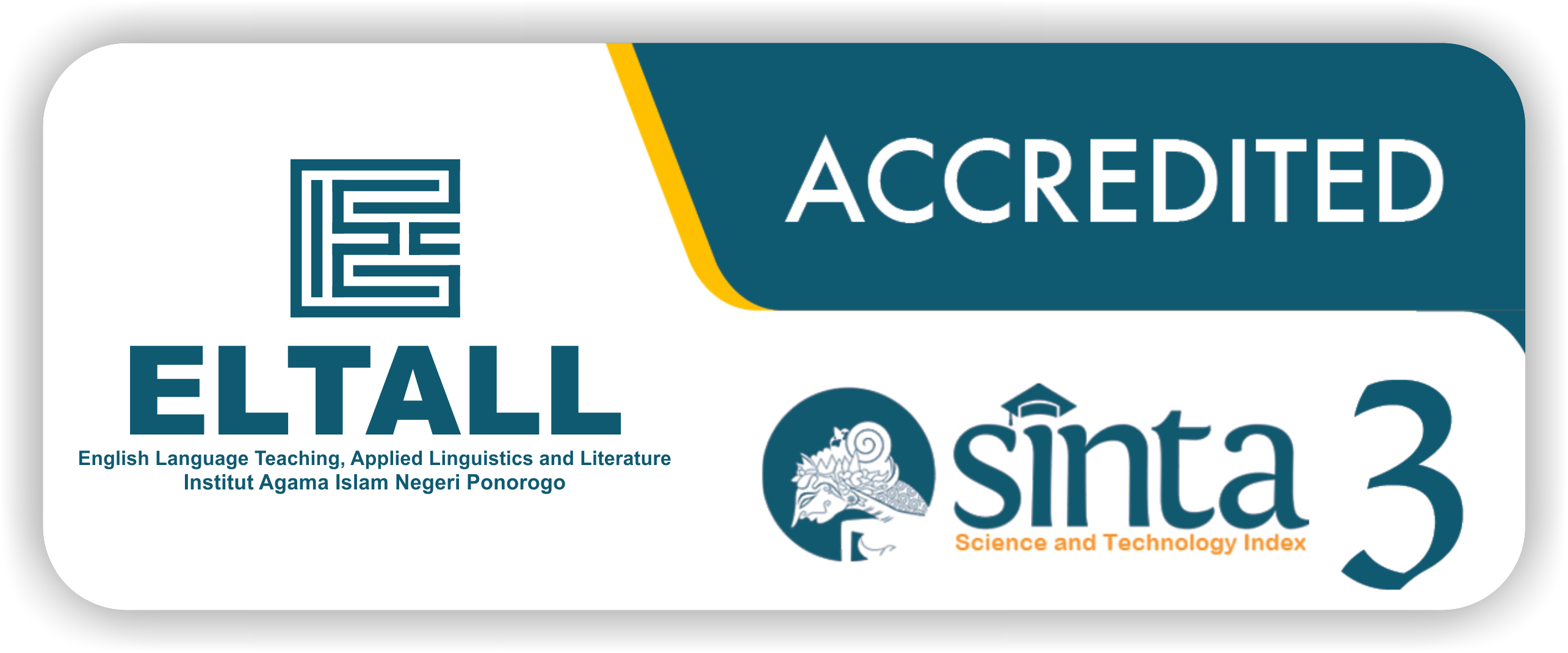The Influence of ICT Integration on ELT in Higher Education: A Systematic Literature Review
DOI:
https://doi.org/10.21154/eltall.v6i1.10794Keywords:
ICT Integration, ELT, Higher Education, Use of TechnologyAbstract
This study aimed to discuss the integration of Information and Communication Technology (ICT) in English Language Teaching (ELT) in higher education based on a systematic review of several relevant articles. The articles analyzed include studies regarding teachers’ knowledge and experiences regarding the use of ICT in English language teaching, as well as the challenges and potential associated with implementing these technologies in the classroom. The findings show that although many teachers, both novice and experienced, show high confidence in using ICT tools, difficulties in pedagogical application and lack of practical training are the main barriers. Some other inhibiting factors are a lack of access to technology, limited infrastructure, and resistance to change among more experienced educators. This article suggests a more holistic approach in preparing educators for ICT integration, including improved professional training focusing on developing pedagogical skills in ICT use and stronger institutional support. Although these challenges are significant, the potential of ICT in improving student engagement and learning outcomes suggests that effective technology integration can significantly impact English language teaching in higher education.
References
Ahmadi, M. R. (2018). The use of technology in English language learning: A literature review. International Journal of Research in English Education, 3(2), 115–125. https://doi.org/10.47689/xxia-ttipr-vol1-iss1-pp432-433
Alkamel, M. A. A., & Chouthaiwale, S. S. (2018). The use of ICT tools in English language teaching and learning: A literature review. Journal of English Language and Literature (JOELL), 5(2), 29–33. https://doi.org/https://joell.in/wp-content/uploads/2018/04/29-33-THE-USE-OF-ICT-TOOLS-IN-ENGLISH-LANGUAGE.pdf
Ammade, S., Mahmud, M., Jabu, B., & Tahmir, S. (2018). Integrating technology in English language teaching: Global experiences and lessons for Indonesia. International Journal of English Linguistics, 8(6), 107. https://doi.org/10.5539/ijel.v8n6p107
Çakici, D. (2016). The use of ICT in teaching English as a foreign language. Participatory Educational Research (PER), IV, 73–77. https://doi.org/http://www.partedres.com
Ciptaningrum, D. S., Putro, N. H. P. S., Sari, N. K., & Hasanuddin, N. (2021). Evaluation of learning process: Knowledge of ICT integration among pre-service English language teachers. REID (Research and Evaluation in Education), 7(1), 46–56. https://doi.org/10.21831/reid.v7i1.30521
Gloria, & Bram, B. (2025). Integrating information and communication technology in English language teaching. Journal of Education and Teaching (JET), 13(1), 1–26. https://doi.org/10.51454/jet.v6i1.460
Haerazi, H. (2024). ICT integration into English language teaching-learning: Insights from some private higher education institutions. Englisia: Journal of Language, Education, and Humanities, 11(2), 48. https://doi.org/10.22373/ej.v11i2.19913
Hashemi, A., & Kew, S. N. (2021). The barriers to the use of ICT in English language teaching: A systemic literature review. Journal of Information and Communication Technologies, 3(1), 77–88. https://doi.org/https://www.researchgate.net/publication/352887550_The_Barriers_to_the_Use_of_ICT_in_English_Language_Teaching_A_Systematic_Literature_Review
Mamatkulovna, U. D., & Tolibovna, G. S. (2024). The impact of ICT integration on teaching and learning in ESL classrooms of tertiary education. Web of Scientist: International Secientific Research Journal, 5(2), 321–325. https://doi.org/https://wos.academiascience.org/index.php/wos/article/view/5011
Purwati, H., & Difinubun, T. N. (2024). ICT integration in the English learning context for the higher education students: Potencies and issues. INTERACTION: Jurnal Pendidikan Bahasa, 15(1), 37–48. https://doi.org/https://unimuda.e-journal.id/jurnalinteraction/article/download/6726/2062
Sabiri, K. A. (2020). ICT in EFL teaching and learning: A systematic literature review. Contemporary Educational Technology, 11(2), 177–195. https://doi.org/https://doi.org/10.30935/cet.665350
Salehi, H., Shojaee, M., & Sattar, S. (2015). Using e-learning and ICT courses in educational environment: A review. English Language Teaching, 8(1), 63–70. https://doi.org/10.5539/elt.v8n1p63
Solak, E., & Cakır, R. (2015). Exploring the effect of materials designed with augmented reality on language learners’ vocabulary learning. The Journal of Educators Online, 12(2), 50–72. https://doi.org/https://doi.org/10.9743/JEO.2015.2.5
Sung, Y. T., Chang, K. E., & Liu, T. C. (2015). The effects of integrating mobile devices with teaching and learning on students’ learning performance: A meta-analysis and research synthesis. Computers and Education, 94(2016), 252–275. https://doi.org/10.1016/j.compedu.2015.11.008
Yuhana, Y., Adiantika, H. N., & Charisma, D. (2022). ICT-ELT Integration in Indonesian Higher Education Context: EFL Teachers’ Perception. International Social Sciences and Humanities, 2(1), 134–139. https://doi.org/10.32528/issh.v2i1.126
Downloads
Published
Issue
Section
License
Copyright (c) 2025 ELTALL: English Language Teaching, Applied Linguistic and Literature

This work is licensed under a Creative Commons Attribution-NonCommercial 4.0 International License.
All articles published in ELTALL (English Language Teaching, Applied Linguistics, and Literature Journal) are licensed under the Creative Commons Attribution-NonCommercial 4.0 International License (CC BY-NC 4.0).
Under this license, authors and readers are free to:
- Share. copy and redistribute the material in any medium or format
- Adapt. remix, transform, and build upon the material
Under the following terms:
- Attribution. You must give appropriate credit, provide a link to the license, and indicate if changes were made. You may do so in any reasonable manner but not in any way that suggests the licensor endorses you or your use.
- Non-Commercial. You may not use the material for commercial purposes.
Notices:
- The licensor cannot revoke these freedoms as long as you follow the license terms.
- No additional restrictions. You may not apply legal terms or technological measures that legally restrict others from doing anything the license permits.
For the full legal code of the license, please visit: https://creativecommons.org/licenses/by-nc/4.0/













